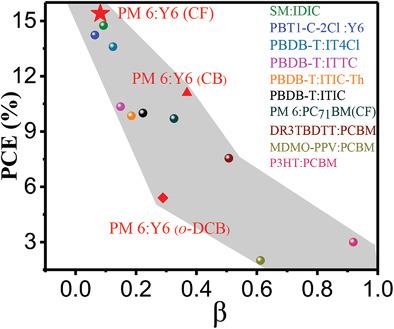当前位置:
X-MOL 学术
›
Adv. Mater. Interfaces
›
论文详情
Our official English website, www.x-mol.net, welcomes your
feedback! (Note: you will need to create a separate account there.)
Vertical Miscibility of Bulk Heterojunction Films Contributes to High Photovoltaic Performance
Advanced Materials Interfaces ( IF 4.3 ) Pub Date : 2020-07-08 , DOI: 10.1002/admi.202000577 Shi He 1 , Zichao Shen 1 , Jinde Yu 1 , Huilan Guan 2 , Guanghao Lu 1 , Tong Xiao 1 , Shuting Yang 1 , Yingping Zou 2 , Laju Bu 1
Advanced Materials Interfaces ( IF 4.3 ) Pub Date : 2020-07-08 , DOI: 10.1002/admi.202000577 Shi He 1 , Zichao Shen 1 , Jinde Yu 1 , Huilan Guan 2 , Guanghao Lu 1 , Tong Xiao 1 , Shuting Yang 1 , Yingping Zou 2 , Laju Bu 1
Affiliation

|
The power conversion efficiencies (PCEs) of organic photovoltaic cells employing donor (polymer):acceptor (small molecule) bulk heterojunction (BHJ) are being rapidly improved. The phase segregation along vertical (film‐depth) direction of the active layer, referring to vertical immiscibility between donor and acceptor, leads to vertically varied and nonlinearly distributed composition, optical and electronic properties. However, the correlation between vertical miscibility and photovoltaic performance is still confusing. Here, it is semi‐empirically found that such vertical variations induced by vertical immiscibility deteriorate PCE. Subsequently, using PM6:Y6‐based binary and ternary BHJ as examples, a combined statistical, experimental, and numerical investigation on the dependence of photovoltaic performance on vertical miscibility is reported. The vertical phase evolution of BHJ significantly depends on solvents and processing methods. As compared with other donor:acceptor systems, polymer:Y6 deposited from appropriate solvents could have the best vertical miscibility which is nearly independent on film‐depth, leading to a higher PCE. PM6:Y6:fullerene ternary blends also have a good and uniform vertical miscibility, forming spatially well‐mixed ternary BHJ. Consequently, under this design guideline, the optimized film‐depth‐dependent miscibility contributes to optimized vertical distribution of optical and electronic properties, leading to an optimized PCE 17.1% with a low sensitivity to fluctuation of film thickness.
中文翻译:

大块异质结薄膜的垂直混溶性有助于实现高光伏性能
使用施主(聚合物):受体(小分子)本体异质结(BHJ)的有机光伏电池的功率转换效率(PCE)正在迅速提高。沿活性层垂直(膜深度)方向的相分离,是指供体和受体之间的垂直不混溶,会导致垂直变化和非线性分布的成分,光学和电子特性。然而,垂直混溶性与光伏性能之间的相关性仍然令人困惑。在这里,半经验地发现,垂直不混溶引起的这种垂直变化会使PCE恶化。随后,以基于PM6:Y6的二进制和三进制BHJ为例,将统计,实验,并报道了有关光伏性能对垂直混溶性依赖性的数值研究。BHJ的垂直相演化在很大程度上取决于溶剂和加工方法。与其他施主:受主体系相比,由适当溶剂沉积的聚合物:Y6可能具有最佳的垂直混溶性,几乎与漆膜深度无关,从而导致更高的PCE。PM6:Y6:富勒烯三元共混物也具有良好且均匀的垂直混溶性,形成空间混合良好的三元BHJ。因此,根据该设计指南,优化的与膜深度有关的可混溶性有助于优化光学和电子特性的垂直分布,从而导致对PCE的优化17.1%,并且对膜厚波动的敏感度低。BHJ的垂直相演化在很大程度上取决于溶剂和加工方法。与其他施主:受主体系相比,由适当溶剂沉积的聚合物:Y6可能具有最佳的垂直混溶性,几乎与漆膜深度无关,从而导致更高的PCE。PM6:Y6:富勒烯三元共混物也具有良好且均匀的垂直混溶性,形成空间混合良好的三元BHJ。因此,根据该设计准则,优化的与膜深度有关的可混溶性有助于优化光学和电子特性的垂直分布,从而导致优化的PCE 17.1%,并且对膜厚度的波动不敏感。BHJ的垂直相演化在很大程度上取决于溶剂和加工方法。与其他施主:受主体系相比,由适当溶剂沉积的聚合物:Y6可能具有最佳的垂直混溶性,几乎与漆膜深度无关,从而导致更高的PCE。PM6:Y6:富勒烯三元共混物也具有良好且均匀的垂直混溶性,形成空间混合良好的三元BHJ。因此,根据该设计指南,优化的与膜深度有关的可混溶性有助于优化光学和电子特性的垂直分布,从而导致对PCE的优化17.1%,并且对膜厚波动的敏感度低。由适当的溶剂沉积的Y6可能具有最佳的垂直混溶性,这几乎与薄膜深度无关,从而导致更高的PCE。PM6:Y6:富勒烯三元共混物也具有良好且均匀的垂直混溶性,形成空间混合良好的三元BHJ。因此,根据该设计指南,优化的与膜深度有关的可混溶性有助于优化光学和电子特性的垂直分布,从而导致对PCE的优化17.1%,并且对膜厚波动的敏感度低。由适当的溶剂沉积的Y6可能具有最佳的垂直混溶性,这几乎与薄膜深度无关,从而导致更高的PCE。PM6:Y6:富勒烯三元共混物也具有良好且均匀的垂直混溶性,形成空间混合良好的三元BHJ。因此,根据该设计指南,优化的与膜深度有关的可混溶性有助于优化光学和电子特性的垂直分布,从而导致对PCE的优化17.1%,并且对膜厚波动的敏感度低。
更新日期:2020-09-11
中文翻译:

大块异质结薄膜的垂直混溶性有助于实现高光伏性能
使用施主(聚合物):受体(小分子)本体异质结(BHJ)的有机光伏电池的功率转换效率(PCE)正在迅速提高。沿活性层垂直(膜深度)方向的相分离,是指供体和受体之间的垂直不混溶,会导致垂直变化和非线性分布的成分,光学和电子特性。然而,垂直混溶性与光伏性能之间的相关性仍然令人困惑。在这里,半经验地发现,垂直不混溶引起的这种垂直变化会使PCE恶化。随后,以基于PM6:Y6的二进制和三进制BHJ为例,将统计,实验,并报道了有关光伏性能对垂直混溶性依赖性的数值研究。BHJ的垂直相演化在很大程度上取决于溶剂和加工方法。与其他施主:受主体系相比,由适当溶剂沉积的聚合物:Y6可能具有最佳的垂直混溶性,几乎与漆膜深度无关,从而导致更高的PCE。PM6:Y6:富勒烯三元共混物也具有良好且均匀的垂直混溶性,形成空间混合良好的三元BHJ。因此,根据该设计指南,优化的与膜深度有关的可混溶性有助于优化光学和电子特性的垂直分布,从而导致对PCE的优化17.1%,并且对膜厚波动的敏感度低。BHJ的垂直相演化在很大程度上取决于溶剂和加工方法。与其他施主:受主体系相比,由适当溶剂沉积的聚合物:Y6可能具有最佳的垂直混溶性,几乎与漆膜深度无关,从而导致更高的PCE。PM6:Y6:富勒烯三元共混物也具有良好且均匀的垂直混溶性,形成空间混合良好的三元BHJ。因此,根据该设计准则,优化的与膜深度有关的可混溶性有助于优化光学和电子特性的垂直分布,从而导致优化的PCE 17.1%,并且对膜厚度的波动不敏感。BHJ的垂直相演化在很大程度上取决于溶剂和加工方法。与其他施主:受主体系相比,由适当溶剂沉积的聚合物:Y6可能具有最佳的垂直混溶性,几乎与漆膜深度无关,从而导致更高的PCE。PM6:Y6:富勒烯三元共混物也具有良好且均匀的垂直混溶性,形成空间混合良好的三元BHJ。因此,根据该设计指南,优化的与膜深度有关的可混溶性有助于优化光学和电子特性的垂直分布,从而导致对PCE的优化17.1%,并且对膜厚波动的敏感度低。由适当的溶剂沉积的Y6可能具有最佳的垂直混溶性,这几乎与薄膜深度无关,从而导致更高的PCE。PM6:Y6:富勒烯三元共混物也具有良好且均匀的垂直混溶性,形成空间混合良好的三元BHJ。因此,根据该设计指南,优化的与膜深度有关的可混溶性有助于优化光学和电子特性的垂直分布,从而导致对PCE的优化17.1%,并且对膜厚波动的敏感度低。由适当的溶剂沉积的Y6可能具有最佳的垂直混溶性,这几乎与薄膜深度无关,从而导致更高的PCE。PM6:Y6:富勒烯三元共混物也具有良好且均匀的垂直混溶性,形成空间混合良好的三元BHJ。因此,根据该设计指南,优化的与膜深度有关的可混溶性有助于优化光学和电子特性的垂直分布,从而导致对PCE的优化17.1%,并且对膜厚波动的敏感度低。











































 京公网安备 11010802027423号
京公网安备 11010802027423号